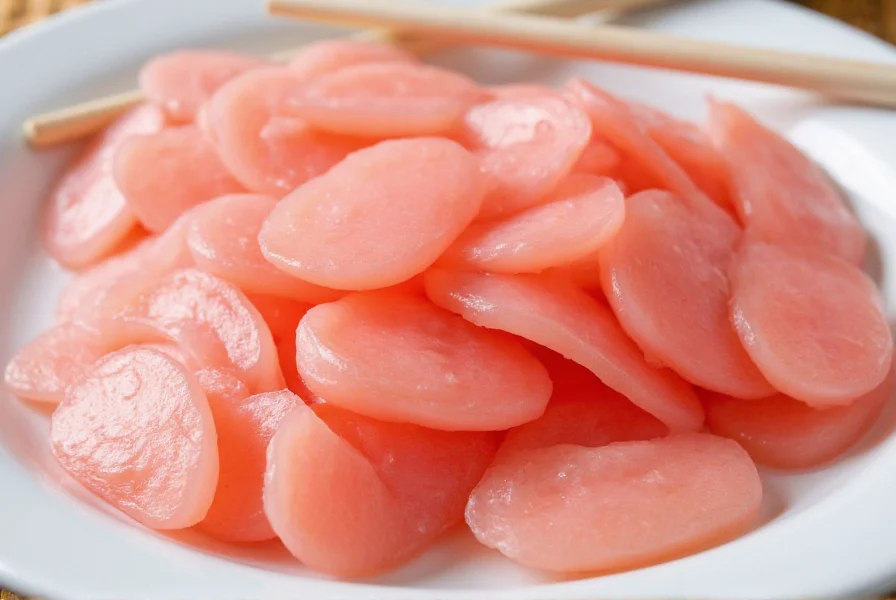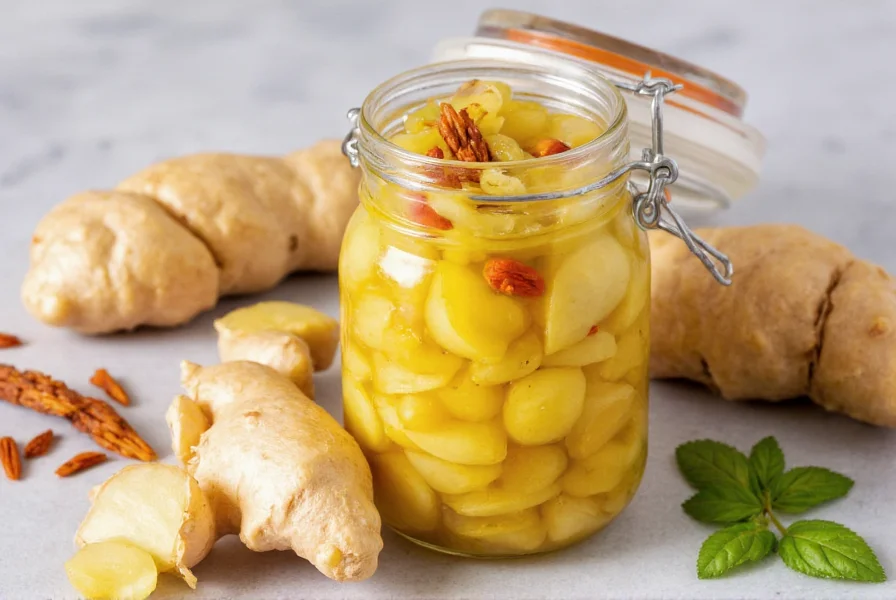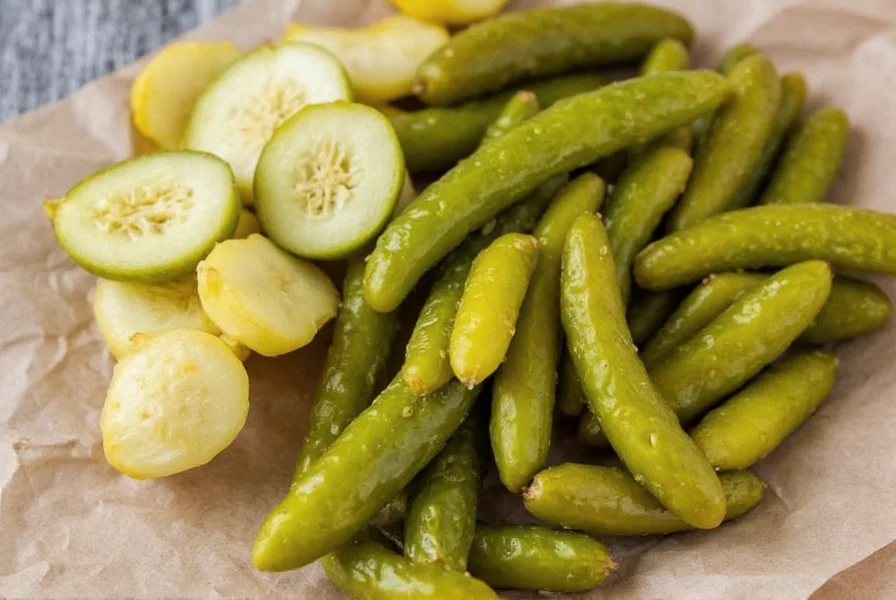Often served alongside sushi, pickled ginger (known as gari in Japanese cuisine) is more than just a palate cleanser. This vibrant pink condiment has gained attention for its potential health advantages that extend beyond its traditional culinary role. Understanding the specific benefits of pickled ginger requires examining both the properties of ginger itself and how the pickling process affects its nutritional profile.
What Is Pickled Ginger and How Is It Made?
Pickled ginger typically consists of young ginger roots sliced thin and marinated in a solution of rice vinegar, sugar, and salt. The pink color develops naturally as the ginger reacts with the vinegar over time, though some commercial varieties may include additional coloring. Unlike mature ginger, which has a stronger, spicier flavor, young ginger used for pickling has a more delicate taste and tender texture.
The pickling process creates an environment where beneficial bacteria can thrive, potentially adding probiotic elements to the final product. This preservation method not only extends shelf life but also transforms the ginger's chemical composition in ways that may enhance certain health properties while preserving others.
Nutritional Profile: Fresh vs. Pickled Ginger
| Nutrient | Raw Ginger (1" piece) | Pickled Ginger (1 oz) |
|---|---|---|
| Calories | 8 | 25 |
| Carbohydrates | 2g | 6g |
| Sugar | 0.2g | 4g |
| Gingerols | High | Moderate |
| Probiotics | None | Present |
| Sodium | Trace | 150mg |
While pickling does increase sugar and sodium content compared to raw ginger, it preserves many beneficial compounds. The fermentation process converts some gingerols (the primary bioactive compounds in fresh ginger) into shogaols, which research suggests may have enhanced antioxidant properties. This transformation creates a unique nutritional profile that offers different advantages than fresh ginger alone.
Digestive Health Benefits of Pickled Ginger
One of the most well-documented pickled ginger digestive benefits relates to its ability to stimulate digestive enzymes. The combination of ginger compounds and the mild acidity from vinegar helps prepare the stomach for food, potentially reducing bloating and discomfort. Many traditional medicine systems have used ginger preparations to address digestive issues for centuries.
A 2020 review published in the Journal of Gastroenterology and Hepatology noted that ginger compounds may accelerate gastric emptying, which explains why many people experience relief from indigestion after consuming pickled ginger. This effect makes it particularly valuable when eaten before or during meals, especially those containing rich or fatty foods.

Anti-Nausea Properties Supported by Research
Scientific evidence strongly supports ginger's effectiveness against various forms of nausea, and pickled ginger maintains these properties. A comprehensive analysis of 12 clinical trials involving over 1,200 participants found that ginger supplementation significantly reduced nausea symptoms across multiple contexts including pregnancy, chemotherapy, and post-surgical recovery.
While most studies used raw ginger or supplements, the active compounds remain present in pickled forms. Many travelers report that consuming small amounts of pickled ginger helps prevent motion sickness. The convenience of pre-portioned pickled ginger makes it an accessible option for managing nausea on the go, representing one of the most practical benefits of eating pickled ginger with sushi or during travel.
Anti-Inflammatory and Antioxidant Effects
Ginger contains potent anti-inflammatory compounds that may help reduce markers of inflammation in the body. Research published in Arthritis demonstrated that ginger extract reduced pain and stiffness in osteoarthritis patients. While pickling alters some compounds, the resulting shogaols appear to maintain significant anti-inflammatory activity.
The antioxidant properties of pickled ginger deserve special attention. Oxidative stress contributes to numerous chronic conditions, and ginger's antioxidant capacity helps combat this process. A study in the Journal of Agricultural and Food Chemistry found that both fresh and pickled ginger extracts demonstrated strong free radical scavenging abilities, with pickled ginger showing slightly different but still substantial antioxidant effects.
Immune System Support and Additional Benefits
While not a cure-all, pickled ginger may contribute to immune health through multiple pathways. The gingerols and shogaols have demonstrated antimicrobial properties against certain bacteria and viruses in laboratory studies. Additionally, the probiotic elements from fermentation may support gut health, which plays a crucial role in immune function.
Some preliminary research suggests ginger compounds might help regulate blood sugar levels and support cardiovascular health, though more studies specifically on pickled ginger are needed. The scientific evidence for pickled ginger benefits in these areas remains limited but promising, warranting further investigation.
How to Incorporate Pickled Ginger Into Your Diet
You don't need to limit pickled ginger to sushi meals to enjoy its benefits. Consider these practical applications:
- Add thin slices to rice bowls or grain salads for a flavor boost
- Chop finely and mix into salad dressings or marinades
- Enjoy 1-2 slices before meals to support digestion
- Use as a garnish for soups or roasted vegetable dishes
- Create a refreshing ginger tea by steeping pickled ginger in hot water
For maximum benefit without excessive sodium or sugar intake, aim for 1-2 tablespoons of pickled ginger daily. Those monitoring sodium should look for low-sodium varieties or make homemade versions with reduced salt.

Safety Considerations and Potential Side Effects
While generally safe for most people, some should exercise caution with pickled ginger. The potential side effects of pickled ginger may include:
- Heartburn or acid reflux in sensitive individuals
- Increased bleeding risk for those on blood-thinning medications
- Blood sugar fluctuations for people with diabetes
- Digestive discomfort when consumed in excess
Pregnant women should consult their healthcare provider about appropriate consumption levels, though moderate amounts are generally considered safe. Those with gallstone issues should also seek medical advice, as ginger may increase bile production.
Conclusion: A Flavorful Addition With Real Benefits
Pickled ginger represents more than just a traditional sushi accompaniment—it's a functional food with legitimate health advantages supported by growing scientific evidence. While it shouldn't replace medical treatment for serious conditions, incorporating moderate amounts into your diet can contribute to digestive wellness, nausea management, and overall antioxidant support.
The nutritional value of pickled ginger makes it a valuable addition to a balanced diet, especially when consumed as part of whole foods rather than relied upon as a miracle cure. As research continues to explore the specific mechanisms behind ginger's health effects, both fresh and pickled forms remain accessible options for those seeking natural approaches to wellness.
Frequently Asked Questions
Does pickled ginger have the same health benefits as fresh ginger?
Pickled ginger retains many but not all of fresh ginger's benefits. The pickling process converts some gingerols to shogaols, which may enhance certain antioxidant properties while reducing others. Pickled ginger maintains anti-nausea and digestive benefits but has lower enzyme activity than fresh ginger. It also gains potential probiotic benefits from fermentation that fresh ginger lacks.
How much pickled ginger should I eat for digestive benefits?
For digestive support, 1-2 tablespoons (about 15-30g) of pickled ginger before or during meals provides optimal benefits without excessive sodium or sugar intake. This amount contains sufficient ginger compounds to stimulate digestion while remaining within reasonable limits for added ingredients from the pickling process.
Can pickled ginger help with motion sickness?
Yes, research supports ginger's effectiveness against motion sickness, and pickled ginger maintains these properties. Studies show that consuming 1-2 grams of ginger (approximately 1-2 tablespoons of pickled ginger) 30-60 minutes before travel can significantly reduce symptoms of motion sickness for many people. The convenience of pre-portioned pickled ginger makes it a practical option for managing nausea during travel.
Is the pink color in pickled ginger natural?
Yes, the pink color in traditionally made pickled ginger (gari) develops naturally when young ginger reacts with the vinegar in the pickling solution. The ginger contains anthocyanin pigments that turn pink in acidic environments. Some commercial varieties may add additional coloring, but authentic Japanese gari achieves its color naturally without artificial dyes.
Does pickled ginger lose its benefits over time?
Pickled ginger maintains most of its beneficial compounds for several months when properly stored in the refrigerator. The vinegar-based solution preserves the ginger's active components, though some gradual degradation of gingerols occurs over time. For maximum benefits, consume within 3-6 months of preparation. The probiotic elements may decrease over extended storage periods, but the primary anti-nausea and digestive compounds remain relatively stable.











 浙公网安备
33010002000092号
浙公网安备
33010002000092号 浙B2-20120091-4
浙B2-20120091-4